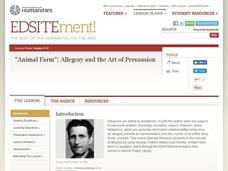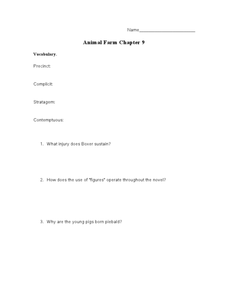Curated OER
"Shooting An Elephant": George Orwell's Essay on His Life in Burma
High school readers examine George Orwell's essay "Shooting an Elephant" for examples of symbolism, metaphor, connotation, and irony. They analyze how these literary tools convey the writer's main point and contribute to the persuasive...
Curated OER
1984, by George Orwell - Fact or Fantasy?
Students read 1984 by George Orwell. They research a country who has dictators similar to Oceania's leaders and create a outline for a paper. In addition, they create a web page from their information.
Curated OER
"Shooting An Elephant": George Orwell's Essay on his Life in Burma
Students read an essay by George Orwell's life in Burma and place it in its cultural and historical context. They identify the main points of the essay and Orwell's use of symbolism in the essay. They explain how each persuasive tool...
Curated OER
"Shooting an Elephant"
Study selected vocabulary terms in George Orwell's "Shooting an Elephant." A chart includes five selections, and learners must record the connotative and denotative meaning for each. A great look at using the context to define vocabulary...
Curated OER
George Orwell's Essay on his Life in Burma: "Shooting an Elephant"
Students read George Orwell's essay "Shooting an Elephant" as an analysis for the historical context. In this historical analysis lesson, students analyze the main points in the essay to identify its cultural and historical context....
National Endowment for the Humanities
Animal Farm: Allegory and the Art of Persuasion
Introduce your class members to allegory and propaganda with a series of activities designed to accompany a study of George Orwell's Animal Farm. Readers examine the text as an allegory, consider the parallels to collective farms and the...
Curated OER
1984 by George Orwell
Readers of Nineteen Eighty-Four engage in a close reading exercise that directs their focus to the key details Orwell provides in the opening paragraphs to introduce his dystopian society. The included worksheeet is divided into three...
The New York Times
Big Brother vs. Little Brother: Updating Orwell's 1984
Government surveillance is an enduring conflict that has become increasingly complex with our nation's use of technology. Add to the understanding of Orwell’s 1984 by using the resources here that display the contemporary actions of Big...
Literacy Design Collaborative
Words Matter: Diction and Orwell's "Shooting an Elephant"
Watch your tone! Scholars analyze how diction in George Orwell's Shooting an Elephant contributes to the tone of the text. Readers watch a video, participate in a word splash, and work through a PowerPoint lesson to help them determine...
Curated OER
Social Movements in American Politics
Students explore American social movements. In this writing skills lesson, students read Orwell's "Politics and the English." Students then apply the rules for writing that are included in the piece. Students follow-up by completing a...
Curated OER
Animal Farm Chapter 9
In this Animal Farm comprehension check worksheet, young scholars respond to 10 short answer questions and define 4 terms pertaining to chapter 9 of Animal Farm by George Orwell in order to help them better understand the novel.
Curated OER
Animal Farm: Chapter 2
In this Animal Farm comprehension check worksheet, students define 6 vocabulary words and respond to 7 short answer questions pertaining to chapter 2 of Animal Farm by George Orwell to help them better understand the novel.
Curated OER
Animal Farm: Chapter 4
In this Animal Farm comprehension check worksheet, young scholars respond to 5 short answer questions and define 6 terms pertaining to chapter 4 of Animal Farm by George Orwell in order to help them better understand the novel.
Curated OER
Animal Farm Chapter 8
In this Animal Farm comprehension check worksheet, students respond to 10 short answer questions and define 4 terms pertaining to chapter 8 of Animal Farm by George Orwell in order to help them better understand the novel.
Curated OER
Animal Farm: Chapter 3
In this Animal Farm comprehension check worksheet, learners respond to 5 short answer questions and define 5 terms pertaining to chapter 3 of Animal Farm by George Orwell in order to help them better understand the novel.
Curated OER
A New Candidate for Animal Farm
Students create an advertising campaign in which a candidate from Animal Farm will run for an upcoming election. In this follow-up activity to George Orwell's Animal Farm lesson, students explore propaganda, rhetoric, and satire as they...
Curated OER
George Orwell's 1984
Eleventh graders engage in a literature study that is concerned with the strengthening of reading comprehension skills while they practice using context clues to arrange meaning to the text. The total assessments for this unit includes...
ReadWriteThink
Decoding the Dystopian Characteristics of Macintosh’s “1984” Commercial
Known as one of the most iconic advertisements of the 20th century, Macintosh's "1984" commercial has become more of a social statement. Present the ad to a new audience of viewers with a lesson focused on identifying dystopian...
The New York Times
Literary Pilgrimages: Exploring the Role of Place in Writers’ Lives and Work
Do the places you have lived influence what you write? Class members research the lives of writers and look for how places these writers have lived might have influenced their writings.
The New York Times
Where to Draw the Line: Balancing Government Surveillance with the Fourth Amendment
The question of how to balance Fourth Amendment Rights with national security concerns becomes critical in an age of planned terrorist attacks, election interference, and fake news. Get young social scientists involved in the debate with...
Curated OER
1984: How Much Fact in Fiction?
Young scholars compare and contrast the society in Orwell's 1984 with modern society. In this 1984 lesson, students research the historical climate in which Orwell wrote the novel. Young scholars create a comparison chart of privacy...
The New York Times
Evaluating Sources in a ‘Post-Truth’ World: Ideas for Teaching and Learning about Fake News
The framers of the United States Constitution felt a free press was so essential to a democracy that they granted the press the protection it needed to hold the powerful to account in the First Amendment. Today, digital natives need to...
Curated OER
Animal Farm: Symbolism and Theme
If you want some help with teaching themes and symbols in Animal Farm, this may be beneficial. After a class discussion about possible themes, class members write a paragraph explaining which they believe is the most important. Next,...
Curated OER
Acting Like a Bunch of Animals: Fables and Human
The video "The Tales of Aesop" traces for viewers the history of fables and identifies their characteristics. The class then goes to the web site "The Fisherman and the Little Fish" where they examine the classic and a modern version of...
Other popular searches
- Animal Farm George Orwell
- George Orwell 1984
- George Orwell's Animal Farm
- Animal Farm by George Orwell
- 1984 by George Orwell
- Animal Farm; George Orwell
- Reading George Orwell
- George Orwell 1984 Math
- Animal Farm, George Orwell
- 1984 George Orwell Movie
- George Orwell 1984 Science
- George Orwell Essays

























